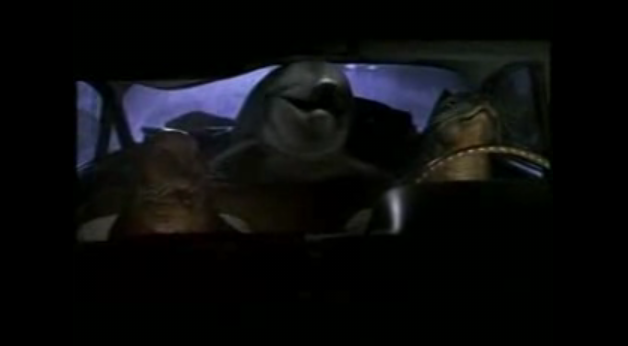#7) FALLING POLAR BEARS: What makes for an effective P.S.A.?
January 25th, 2010
The assumed success of issue-oriented documentaries like “An Inconvenient Truth” has left a lot of activists thinking it’s some sort of panacea — make a documentary feature film and suddenly the world will show up in droves to learn the details of your cause. If only it were that easy. First off, the polls have shown “An Inconvenient Truth” produced no net increase in support or concern about global warming as an issue. Secondly, the movie made a lot of noise, but they had a lot of money behind it. And third, what the polls do show is that the vast majority of people who saw it at theaters were the “already converted,” and mostly supporters of Al Gore. It didn’t manage to do much in terms of reaching the non-converted.
This is where Public Service Announcements (PSAs) come in. The cool thing about a PSA is that they give you a chance to throw your message out in front of people who didn’t ask for it and really don’t want to hear it. In 2005 we did just this with our Tiny Fish PSA (criticizing fishermen for over-fishing) which caused a stir when it aired in the Central California Coast. In a subsequent video a fisherman from Morro Bay told us in detail about sitting down with his kids to watch “The Simpsons,” only have our PSA shown right at the start. He said, “My kids are looking at me and wondering why there’s smoke pouring out of my ears!” That’s called reaching OUTSIDE the choir with your message. And is why I continue to remain interested in PSAs. So here is a brief overview of some qualities of PSAs, prompted by my recent viewing of the Falling Polar Bears PSA.
Okay, let’s begin this essay with a viewing assignment. Please take 4 minutes to watch the following four PSAs from the past four decades:
Now I’m going to construct my own set of criteria with which to evaluate these PSAs. This is totally subjective and very much just my own thoughts, based on what I’ve learned about filmmaking and mass communication both through film school and through having made a series of PSAs. Here are a few of the key elements:
THE INTENDED ACTION (more than “creating awareness”)
I took a course on making instructional videos long ago and the instructor had a very good suggestion which is equally applicable to PSAs. He said you should start the process of designing a video by asking the question, “What’s the ultimate hoped for ACTION that will result from the video?” The vast majority of people will answer this question with something along the lines of, “We hope that the viewer will have increased awareness of the issue and problems.” That, unfortunately, is a rather lame answer. It’s too vague and passive. Awareness by itself is rarely enough to make the effort worthwhile. You need to say to yourself, “The perfect result of this video is for the viewer to see it, turn off the television set, go outside and … (whatever you want — organize a bake sale, stage a protest, start a riot).” The key thing is to aspire to cueing some PHYSICAL ACTION as a result of the video rather than just hoping “to make people think.” And here once again is where the academics find my message annoying. They will say, “What’s wrong with thinking?” Nothing. It just isn’t enough by itself — it needs to lead to something, namely action. Too often academics get together in committees where they talk and talk but never get anything done (I know, I was a professor).
VISUAL MESSAGING (turn off the volume)
It’s a visual medium. I say this over and over again in my book because … they said it to us over and over again in film school. It just is. If the narrator says one thing (like the ocean is having problems) and the visuals say something different (like showing beautiful ocean images which say to people that the ocean is in wonderful shape like you see in oil company commercials) nobody’s gonna hear a damn word the narrator says. It’s the visuals that the broad audience walks away with. So the challenge with a good PSA is to take your message and translate it into images that will convey your message in a compelling manner that will make people do things. And the general test for whether you’ve accomplished this is whether if you watch the PSA with the volume turned off, does the message still come across.
REPEAT VIEWING (The “4 to 7″ Rule)
For Shifting Baselines we produced a PSA with comic actors. Our distributor for the PSA, Banyan Communications of St. Louis, said there’s a general rule of thumb that people need to view your PSA four to seven times before they are going to finally do this “Intended Action.” In other words, the first few viewings are just going to bounce off them with nothing happening. It’s not until the fourth time that most people finally start to sit up and say, “Excuse me, but what the hell is this thing I keep seeing on my TV — the commercial with all the actors playing bad music — what’s it about?” They might enjoy viewing it repeatedly, but it’s still going to take them a while to actually begin thinking about it. The main point of this is that if your PSA doesn’t manage to score repeat viewing, you probably might as well have not done it. There are no magic bullets, but if you can fire a normal bullet enough times, you will eventually begin to hit targets.
BRUTE FORCE (sometimes sheer muscle/money can work)
The potential for a PSA to succeed is going to be a function of two main factors — how appealing it is, and how much muscle (in the form of money) is put behind it. You might get lucky and end up with a “viral video” that explodes onto the internet and racks up ten million views in just a week. But “we’re gonna make a viral video” is NOT a strategy. There is no guaranteed formula for making one, you pretty much just have to get lucky. One of the handicaps academics suffer from is the tendency to believe in the absolute power of ideas alone. They think it’s as simple as making a brilliant PSA then watching it explode across the internet as a viral video. But look at the content of just about all the major viral videos — a chipmunk glaring? A dancing wedding? It’s not a venue for serious messaging. The real truth is a whole lot less pretty, as you’ll see with the McGruff the Crime Dog PSA.
AROUSE AND FULFILL vs. UNLIKEABILITY (walking the fine line)
Two of the major themes of my book are actually in opposition to each other. A number of sharp people have caught this and sent me emails about it. And they are right. With the first principle, “Arouse and fulfill,” you need to provoke people to arouse their interests. But if you provoke them the wrong way or too much you can cross the line into unlikeability and then you’re actually making a mess of things. This is a major dilemma for television commercials and PSAs. A very good example of this from a few years ago was “Digger the Dermatophyte,” in commercials for Lamisil, the product that kills toenail fungus (a friend of mine used to complain at length about how much that spot upset her). You can find a number of websites detailing how nauseating and creepy the ads were. MSNBC picked it as one of the worst tv commercials of the year for 2003. And of course the bottom line is, you don’t see the ads any more. They managed to arouse and fulfill, but were just plain unlikeable.
So let’s consider each of these four sample PSAs.
THE CRYING INDIAN – heartstring pulling
Okay, you’re probably bugged by the title, but that’s what it’s referred to as, mostly because the term “native American,” wasn’t in widespread use back then. And really, that’s the lesser worry — more interesting is that the actor, “Iron Eyes Cody,” wasn’t even close to native American — he was Siclian, born Espera Oscar de Corti. But I doubt any environmentalists have ever protested the PSA. It’s one of the most famous PSA’s ever made. It’s remembered by virtually everyone watching television in the early seventies. Today, when you talk to people of that generation about making an environmental PSA, they immediately point to it. Visually, it was very well made. It consists of two simple moments — people throwing litter out their car window, and a native American weeping. Could you possibly reach for any deeper sentimental icon than that? Native Americans are held up with a reverential virtuousness by the environmental movement (even though they ran a bunch of North American species to extinction), so the heartstrings were already in place for this spot to work. But it really isn’t a piece of entertainment that you’d want to watch more than once on your own. Surely much of its impact had to be a function of the amount of brute force behind it in the massive numbers of viewings Americans were subjected to. Bottom line: The Ad Council helped power drive this PSA into the brains of Americans, back in an age before Reagan. There’s not been anything like it for the environment since (which is a whole other story).
TAKE A BITE OUT OF CRIME – the power of brute force
I include this PSA because of an exercise I did with a group of USC freshman about five years ago. I was speaking to them about PSAs in general and asked if any of them could think of any PSAs they’ve ever seen on television. They were all born in the mid-80’s, and the only PSA they could think of was the McGruff the Crime Dog: Take a Bite Out of Crime PSA. They ALL remembered it. When I asked them whether they remembered it because it was “cool,” they ALL groaned and said, “No! We remember it because it was played during Saturday morning cartoons, over and over and over again.” Clearly a case of brute force penetration — taking a square peg and pounding it into everyones round holes (so to speak). As far as it’s design, it’s not particularly effective — just a series of dull scenes that require narration to completely make sense of them, such as the movers who are actually criminals and the neighbors who figure them out. Without the narrator you might think it’s a commercial for a moving company for most of it. As for entertainment value, one viewing is more than enough — there’s nothing exceptionally fun or clever to make you want to show it to your friends.
DELINQUENT OCEAN MAMMALS – irreverent humor
I think this is the most underutilized and underappreciated PSA in the history of ocean conservation. It was created by Mark Gold, the brilliant longtime leader of Heal the Bay in Santa Monica, California, and his brother who does special effects work on commercials. When he showed it to me in 2002 he said they had created it in the late 1990’s, everybody liked it, but it just never scored much air time. It’s really funny, has high production value, makes a good (albeit vague and general) point, and really is enjoyable to watch several times. Visually it’s not a great piece in terms of conveying the message — there’s no images of the actual problem (nothing like people dropping litter out the car window), but still it was catchy. Which demonstrates the need for a certain amount of brute force. As great and fun as the PSA was, it didn’t propel itself to a mass audience. Someone needed to put some major money into buying air time for it in order to make that happen.
FALLING POLAR BEARS – shock and “Aw, why’d you have to be so graphic?”
Okay, this is the most fascinating one, and the thing that prompted me to delve into this entire topic for this essay. We could fill pages and pages with thoughts and blogposts and comments on this PSA. I had the guys who work with me spend a couple hours searching the web to see what’s been said about it. There’s plenty, with all sorts of columnists in the U.K. (where it was produced) opining on basically the “arouse and fulfill vs. unlikeability” dilemma. The Guardian says the PSA ” … inevitably begs the question do these shock tactics actually work to shift the public’s attitudes and behaviours?” Someone on the Huffington Post gets all politically correct and suggests that the “shocking imagery threatens to weaken their message.” A number of writers pointed out how the PSA probably wouldn’t work well in the U.S. (would be too unlikeable) because the polar bears are too similar to people jumping out of the Twin Towers during 9/11. Lots and lots of opinions, but we couldn’t find any data. So I’ll just add my opinion.
I think the spot is awesome. It sticks with you. It “penetrates.” I did a segment on NPR’s Talk of the Nation in July 2008 which the host, Neal Conan, titled, “Cutting Through the Green Fog of Environmental Media.” This PSA goes right to the heart of what he was talking about. He began the segment by asking Al Gore, “What are you gonna do, Al — there’s just too much boring environmental media being produced.” Gore had nothing of substance to say.
This PSA cuts through it. It arouses your interest with the falling objects. Then it starts to horrify you with a few distant objects that are clear enough to recognize as polar bears. Then it ramps things up, increasingly graphic, until the big payoff of the huge bear landing on the roof of the parked car which is absolutely disgusting. But the production value is so good — so realistic — that it draws you in, and finally, after having your interest seriously aroused, it fulfills by making the connection to greenhouse gas production by airplanes.
I really love this PSA. Excessive air travel is one of the stupidest traits known to humans. It has bugged me since the early 1980’s how many environmentalists fill their years with non-stop travel, jet setting around the globe to save it. That is the sort of environmental idiocy that I think was a major source of the fuel inside of Michael Crichton in his final years as he attempted to take on the global warming movement with his book, “State of Fear.” His attacks on science were misguided, but the critique of environmental largesse wasn’t.
Anyhow, its a gutsy PSA. Does it work or not? Who knows. There are just too many intangibles to draw a firm conclusion. In my book I cited the great article by Ken Auletta in the New Yorker that asked the question of whether television commercials even work any more. His conclusion was pretty much that it’s harder than ever to quantify the effectiveness of such mass communication, but the obvious commercial success of companies like Aflac that can be directly linked to their television commercial campaign forces you to conclude that yes, they still work, we just can’t measure how well they work. The same is true, and even worse, for PSAs.
I think that given enough brute force it definitely could “work,” in the same way that the “truth” campaign by the anti-smoking lobby helped reduce smoking in the U.S. Many of those PSAs, featuring victims of throat cancer speaking through voices boxes, were undeniably shocking and effective. But without the sort of financial muscle that they had (rulings against the tobacco companies provided them with hugs sums of money) it’s doubtful the PSA will amount to much more than a curiosity.
DRIVING THE LEAD WEIGHT UP TO THE BELL
I’m making this stuff up as I go along. Anyone who has heard me speak has probably heard me say this. But that said, let me give you my overall take on how this messaging stuff works.

Driving the lead weight up to the bell
It’s VERY difficult to penetrate into the brains of other people. It’s much easier to get into their hearts, guts, and (easiest of all) sex organs. That’s why in the book I so strongly recommended the idea of using these lower organs as the starting point in achieving the “arouse” part of the equation. But once you’ve gained access into the body (strange way to think of this stuff, yes?) then the challenge is to make your way up to the brain. THAT is where the repetition element comes into play. That is where you need the 4 to 7 exposures. You made the viewer laugh, sigh, or squirm with the first viewing. The question is whether you can keep hitting them, with the idea being that each time you do, you’re pushing the lead weight up higher and higher in the body until you finally ring the almighty bell in the cerebellum and something significant starts to happen.
This is why I think the Falling Polar Bear PSA is good. If they could only manage to get people to see it 4 times, they could start to get their message across a bit. I hope they’ll make more PSAs with that specific creative “voice.” It’s what I think is needed, much more than the beautiful shots of polar bears that virtually every large conservation group uses for raising money.
I’m not sure what more to say at this point, other than to close with the best comment we could find about the Falling Polar Bears PSA:
“How did those polar bears get up in the sky? Polar bears can’t fly, so someone must have kidnapped them, loaded them on a PLANE, and then dropped them from a couple thousand feet. How much fuel does a plane full of polar bears use? I bet it uses more fuel than a plane full of people considering how huge polar bears are and how low the pilot would have to keep the air conditioner up to help the bears feel at home.”



